Abstract
What happens when you press the sine key on your calculator? How does a calculator quickly produce the values of trigonometric functions? For instance, how does the TI-89 calculate sin 1.0? You might be surprised to know that the calculator does not use series or polynomial approximation, but rather a simple algorithm called the CORDIC method. In fact, the CORDIC method is used for almost all function evaluations (trigonometric, logarithmic, exponential, hyperbolic, inverse functions, etc.), and even multiplication and division. In this paper we will present the main ideas of the CORDIC method along with some elementary examples.
References
Pulskamp, R.J.; Delaney, J.A. (1991) “Computer and Calculator Computation of Elementary Functions”, UMAP Module 708.
Schelin, C.W. (1983) “Calculator function approximation”, American Mathematical Monthly 90(5): 317–325.
“Transcendental Function Algorithms”, Post from Texas Instruments to Graph-TI mailing list, March 8, 1993.
Volder, J.E. (1959) “The CORDIC trigonometric computing technique”, IRE Transactions on Electronic Computers, volume EC-8, No. 3, September: 330–334.
Walther, J.S. (1971) “A unified algorithm for elementary functions”, Joint Computer Conference Proceedings, Spring: 379–385.





